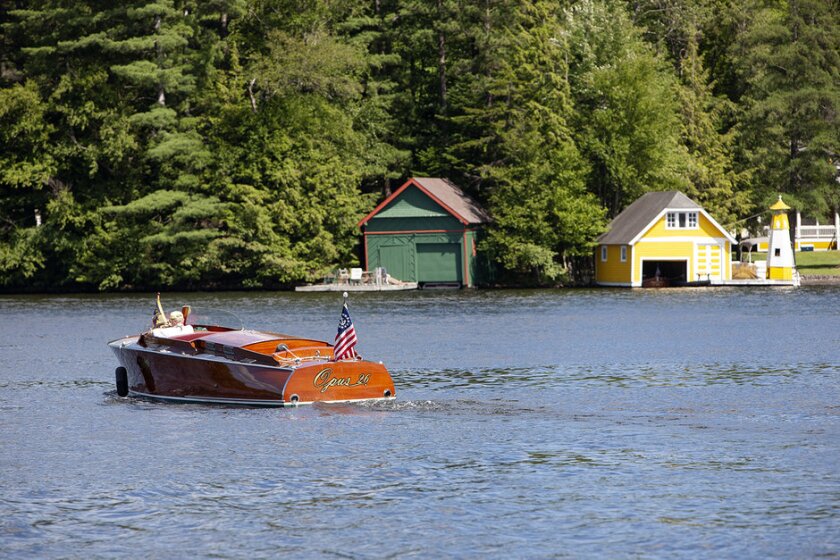
Photos by David Kidd
Nearby, a mother watches her two young children play at the water’s edge. The town didn’t bring in any sand this year, so the kids make do, scooping up mud with their shovels and pails. But they won’t be swimming today. “I have not seen the water this brown,” says the mom. “It’s been a battle all summer, just with how not clear the creek has been.”
With no one to watch over, a teenage lifeguard occupies herself with a laptop. “It’s because of the storm that just came through,” she says. “It clears up all the time.” She’s right. Occasional turbidity — or clouding of the water — has always been a problem in the Esopus Creek, the result of fine clay particles that become suspended in the water after a storm. To demonstrate the concept, Gail sticks a foot in the water and swishes it around. “See how it doesn’t settle?”
Typically, the creek clears in a matter of days. The bigger problem is when the water turns brown because of actions taken 20 miles upstream at the Ashokan Reservoir.
A Growing Demand for Water
As the 19th century came to a close, New York City was rapidly outgrowing its supply of fresh water. By 1905, city planners had identified the Catskill Mountains region as an ideal location for a new reservoir system. Using eminent domain, 2,000 residents along the Esopus Creek were displaced before four hamlets were flooded and another eight relocated. Completed in 1915, the Ashokan Reservoir and the system of tunnels and aqueducts that deliver its water to New York City were considered a marvel of the modern world.

Naturally filtered by the rugged terrain of the Catskills watershed, New York City’s water is considered to be some of the best anywhere. But there is a downside.
Water entering the Ashokan’s west basin is often clouded by microscopic clay particles, picked up from eroded streambanks. Held in suspension, the fine particles give the turbid water a murky, reddish-brown color. Because they are so small, it can take a long time for the clay to settle. Once settling has occurred, the now-clear water is transferred to the east basin and from there it makes the 90-mile downhill journey to New York City through a system of aqueducts.
Not all of the clear water goes to New York. Following state protocols, a prescribed amount is released into the Lower Esopus and then on to the Hudson River. Increasingly though, brown turbid water also ends up in the Esopus. Unlike natural events, when the water clears up within a few days, it can take several weeks or even months for that to happen when the reservoir releases turbid water into the creek.

Denied the use of alum in the 1990s, the solution was to dump the dirty water, much to the dismay of Saugerties Town Supervisor Fred Costello. “They dumped the most turbid water through the Lower Esopus down on us,” he says. “Fifteen years of that has had a dramatic impact. Especially here in Saugerties.”
“No combination of infrastructure and operations are going to reach a point where turbid water never goes down the creek again,” says Bosch. “That’s an irrational expectation. The question is, what can we do to minimize the duration and the number of times when that water goes down the creek.”

(New York City Department of Environmental Protection)
The Cost of Clean Water
Besides serving on the Saugerties town board, Leeanne Thornton also serves as president of the Esopus Creek Conservancy, a 161-acre preserve directly across from the village beach, where Gail Porter launches her kayaks. “You could stand on the deck and see fish in the water,” she says. “Now you can’t see anything. You don’t see turtles sitting out on the logs anymore.”
Recently, a dramatic increase of invasive species has plagued the Esopus, especially where the creek widens in front of the beach. Water chestnuts and milfoil were thriving to the point where the beach was closed for periods of time in 2018. A year later, the town purchased a floating harvester for $58,000. There is already talk of adding another. “Five years ago, that wouldn’t have been anything that we would have felt was necessary,” says Thornton. Many suspect a correlation between the increase of invasive plants and dumping dirty water from the Ashokan Reservoir. Fred Costello agrees. “Absent the harvester, that looks like an open body of water,” he says. “But if we didn’t harvest the milfoil and the water chestnut, it would look like a swamp.”
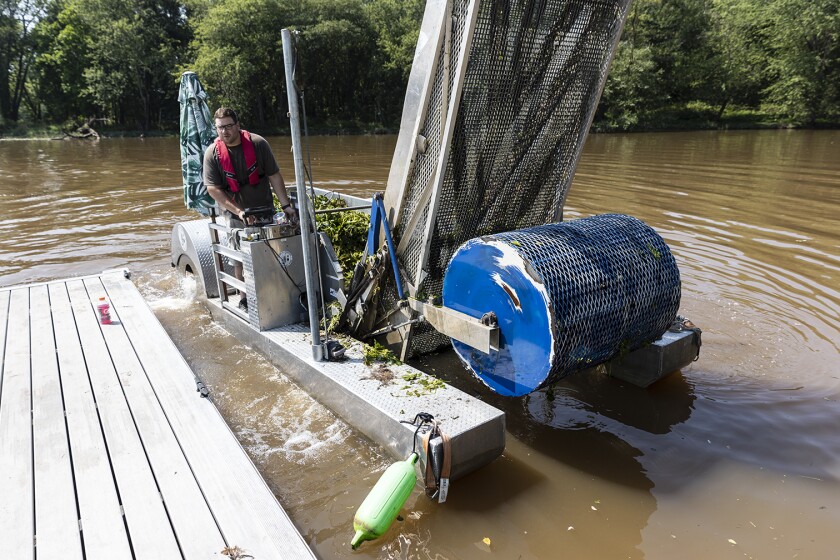
Gail Porter worries that people won’t want to rent one of her kayaks if they think the creek is in bad shape. “It was bad, probably a month ago,” she says. “It floods, and there’s brown water and it’s disgusting and it’s horrible.”
Costello hears often from fishermen about the dwindling bass population. “You would regularly see a lot of boats out there fishing,” he says. “You don’t see that at all anymore.”
But Saugerties’ supervisor readily admits to the benefits that come with the Ashokan nearby. “The reservoir is an outstanding taxpayer,” he says. “[Many local] areas get a significant amount of their tax base because of the reservoir.” The Ashokan also provides employment for many of the locals. “They’re all good people,” he says. “They are sensitive to a lot of what we are saying. But their primary mandate is to provide clean drinking water to the city.”
“Would it make sense to build something that cost $5 billion if you use it once every 10 years?” asks Adam Bosch. “We’re responsible to rate payers. We have to be responsible to them.”
Watching Over the River
About a mile east of the village beach, where the Lower Esopus empties into the Hudson River, Patrick Landewe lives with his wife and child at the Saugerties Lighthouse. Refitted with a solar-powered automated light, the station still serves as an aid to navigation. But the lighthouse keeper’s duties now revolve around maintaining the historic landmark, and acting as host to overnight guests. Two rooms are reserved as a bed and breakfast. “They still call us ‘keeper,’” he says. “Inn keeper, grounds keeper, bookkeeper.”
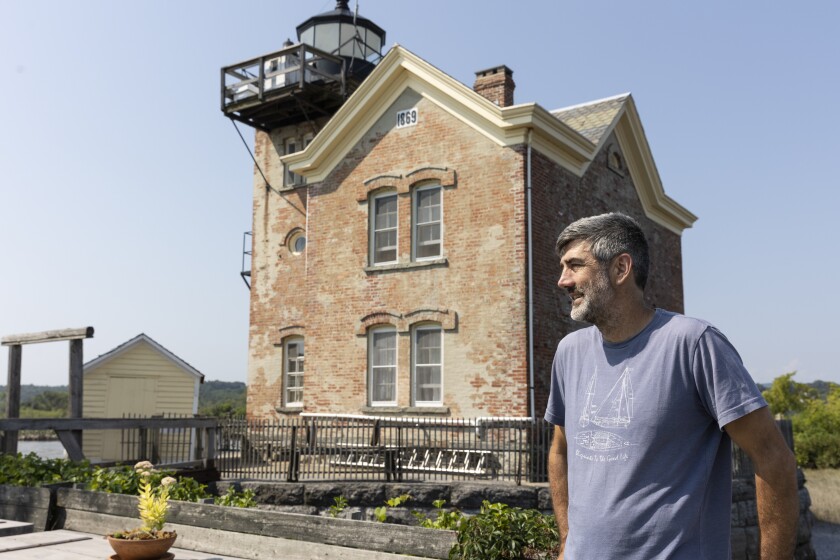
Landewe is convinced that climate change is exacerbating the problem. He first took notice of the change in 2005 when the Ashokan overflowed, sending massive amounts of water over its spillway, causing major flooding downstream. “That really woke up the municipalities to the issues of the reservoir,” he says. “But it also woke up New York City to the fact that they’re going to have to contend with these major storms.”
Patrolling the Hudson
Twenty miles south of Saugerties, John Lipscomb is pulling away from the dock at the Kingston waterfront. “RIVERKEEPER” is spelled out in tall black letters along the hull of his 36-foot-long repurposed fishing vessel. A few puffy clouds hang low in the late summer sky.
With three-year-old yellow lab Batu aboard, Lipscomb makes a slow half circle on the Rondout Creek, eventually pointing toward the Hudson, just a short distance away. He stops for a minute to chat across the water with the crew of the Clearwater, a replica sloop dedicated to protecting the Hudson River.
Before he gets to the Rondout Lighthouse, he leans out his side window and challenges a couple of high school rowers to a race. “Let’s go!” he says. If not for the fact that they were pointed in the opposite direction, the kids would have won. The Riverkeeper boat rarely gets above six knots.
Covering more than 5,000 nautical miles a year, Capt. Lipscomb has been patrolling the Hudson from March through December, for every one of the past 21 years. When on patrol, he and Batu sleep aboard the boat. “His community goes all the way up into the Mohawk River and all the way down into New York Harbor,” Lipscomb says. “He’s great company.”

With Batu peering over the side, Lipscomb slows to point out a water treatment plant on the western shore. The facility serves the town of Esopus, one of seven municipalities that have banded together over concerns about the quality of water they take from the river. It was three years ago that Rhinebeck Mayor Gary Bassett recognized a threat.
Aerial View of the Lower Esopus Creek
Ashokan Esopus 2Turbidity, courtesy of Michael Nelson, Vimeo.
Small Towns Consolidate Their Power
Alarmed about a proposal to park oil-laden barges on the Hudson, the mayor shared his concerns with Riverkeeper’s Dan Shapley, a water quality expert. The two quickly came to the conclusion that by itself, Rhinebeck has no political power. “But if you start to add up [the seven communities], now you’ve got 100,000 people,” says Shapley. “Suddenly it sounds like something that people will pay attention to when you raise a concern.”
Within six months, all seven communities had officially signed on.
“That’s unheard of in government,” says Bassett. “To get seven municipalities to agree on a common interest in that short a time and form an organization. It’s been a tremendous success.”
Calling themselves the Hudson 7, the group’s members include the towns of Esopus, Hyde Park and Lloyd, together with the town and city of Poughkeepsie and the town and village of Rhinebeck. Because they all depend on the Hudson for their drinking water, turbidity in the Esopus Creek and its effects on their own infrastructure is a major issue for the group.
When turbid water makes its way into the water intakes of communities downstream, it is not only inconvenient for them, but costly as well.
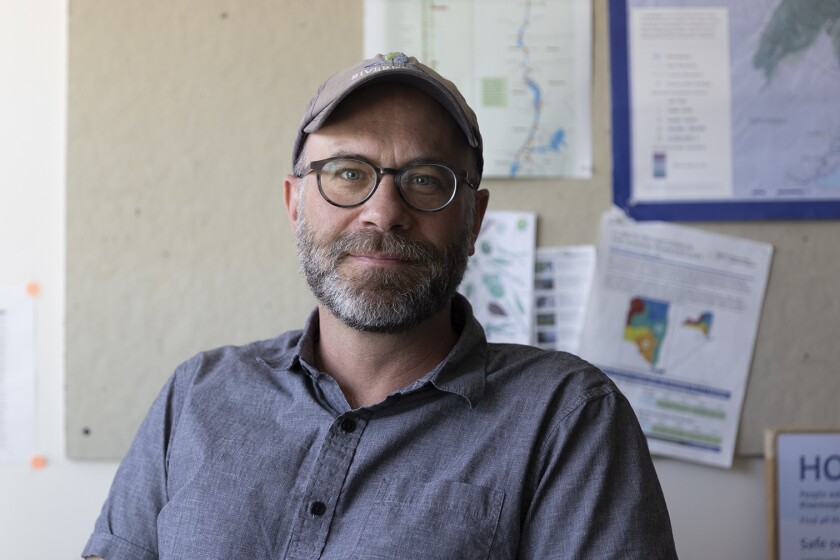
Solving the problem of turbidity in the Esopus and Hudson is probably beyond the century-old engineering in use today. “This is a reservoir that has served well for 100 years,” says Riverkeeper’s Dan Shapley. “We’ve got to build it for the next 100 years, and that’s going to take some actual investment, because the climate is changing. The issues are changing. And we have to be good neighbors, as well as getting our drinking water.”
Lighthouse keeper Patrick Landewe is blunt in his assessment. “The local residents have always gotten the short end of the stick.”
An Ongoing Problem
Leeanne Thornton, of the Esopus Creek Conservancy, remembers a time when most of the village children learned to swim in the Esopus. “Being able to swim out to the dock and back, that was a rite of passage for kids,” she says. “This same group of adults now, when they bring their children to the beach, it’s ‘I’m not letting them go into that water. It’s disgusting.’”
Thornton is sure she knows why things are different today. “We didn’t have [the turbidity problem] until the releases started,” she says. “There’s been a direct correlation from the dumping starting to the negative visual impact on this community.”
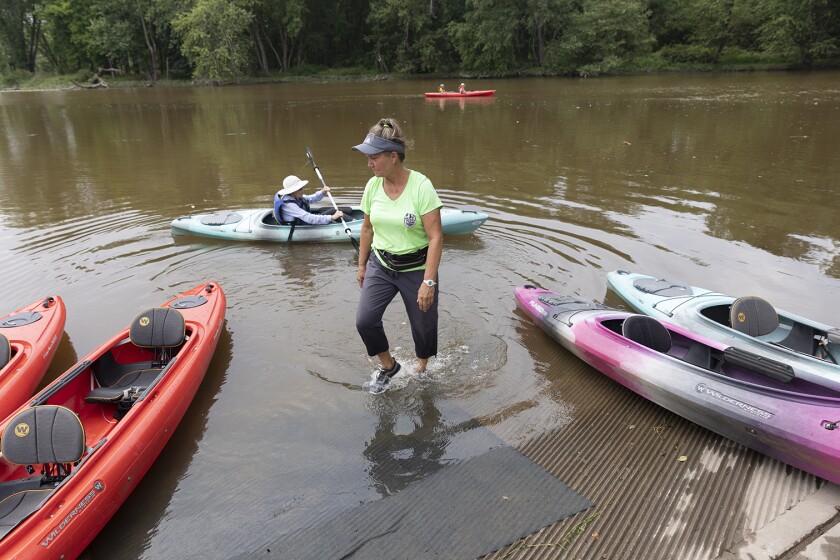
Leeanne Thornton takes the long view. “We want another generation to really be able to enjoy the beauty here.”
